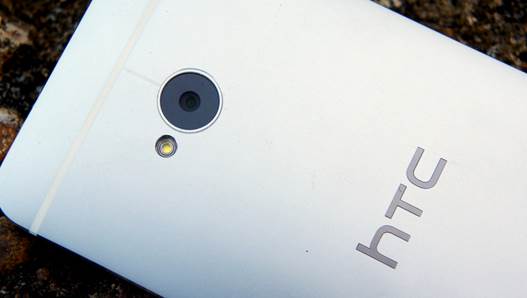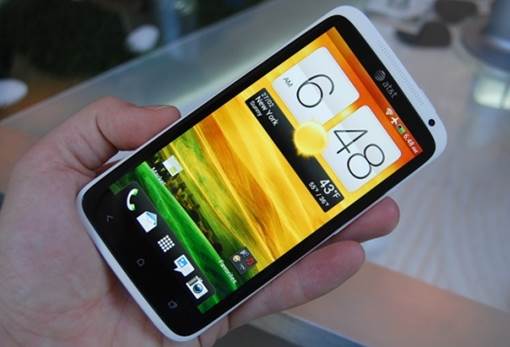The top end is where things become a little
more interesting. The 3.5mm headphone jack is not new, but the power button has
two ways: it holds concurrently as a role of IR blaster that is capable of
transmitting and receiving, allowing you to use the device as a TV remote.
Since the power button is located on the left, and locking and unlocking the
One may be somewhat inconvenient for people who have the habit of holding the
phones in their left hand.

The
top end is where things become a little more interesting. The 3.5mm headphone
jack is not new, but the power button has two ways: it holds concurrently as a
role of IR blaster that is capable of transmitting and receiving, allowing you
to use the device as a TV remote.
Now we come back to the back side, which
itself is an unusual thing in terms of geometry and simplicity. Two
polycarbonate strips are arranged the top and the bottom, neatly lined up with
the top and bottom of the 4.7-inch screen on the other side. Looking closely,
you are able to see a noise reduction mic in the top strip. The camera lens is
located in the middle of the back, just below the top strip; it is surrounded
by a thin layer of polycarbonate and is slightly indented to keep glasses from
getting scratched. You'll find an LED flash on the left of the camera, while
the HTC logo is obligatory to sit in the center of the device, and Beats Audio
branding has a place right above the bottom strip. An NFC transmitter is built
into the back around the camera module. However, it is a pity that one thing
you will not find here is the wireless charging capability. Sorry, everyone.

The
camera lens is located in the middle of the back, just below the top strip; it
is surrounded by a thin layer of polycarbonate and is slightly indented to keep
glasses from getting scratched. You'll find an LED flash on the left of the
camera, while the HTC logo is obligatory to sit in the center of the device.
Finally, as you may have guessed at this
point, the 2300mAh battery inside the One is not impossible to remove or even
access. This is no surprise to anyone who has ever used an HTC monolithic phone.
There is no place to mount the microSD card, so you will have to be satisfied
with the 32GB or 64GB of internal storage.
There are a lot of things going on under
the shell: the One is granted power by a 1.7GHz quad-core Qualcomm Snapdragon
600 (APQ8064T), an Adreno 320 and 2GB DDR2 RAM. While there are two basic
versions of the device - the UL and LTE-less U – there are six different SKUs
that have six different groups of LTE and HSPA+ bands. All of the units are
quad-band GSM/EDGE (850/900/1,800/1,900MHz), but it becomes more complicated
when the speed increases: our test model, which was built for the European
frequencies, features 900/1900/2100MHz UMTS/HSPA+ (3G) and 800/1800/2600MHz
LTE. The "U" provides the same three frequencies and adds 850MHz,
while the Asian version uses 850/900/1900/2100MHz 3G and 1800/2600MHz LTE. Have
you confused yet? Please tell more about the American models. AT&T will
provide850/1900/2100MHz 3G and 700/850/AWS/1900MHz LTE. T-Mobile sports
850/AWS/1900/2100Mz 700/AWS 3G and LTE. Finally, the version of Sprint uses
700/AWS 3G 800/1900MHz CDMA and 1900MHz LTE.
If that last paragraph of specifications
did not make you tired, maybe the full data sheet below will do that. We hope
not, because we have much more to discuss.
Screen
We complimented the 720p S-LCD2 screen of
the One X when it was first launched, and even there were several things to
love more a few months after the Droid DNA was released with a 1080p S-LCD3
screen. Having gathered such a momentum, we did not expect anything other than
the best from the One. And of course, on paper, it did not disappoint: the One
has the number of pixels that is similar to the DNA, except that they are
stuffed into a 4.7-inch screen (for the technique, it is 4.65 inches). For
those who love the current pixel density, which means that the One provides an
incredible density of 468ppi. The setup appears to be great on paper, but how
does it perform in real life?

The
One has the number of pixels that is similar to the DNA, except that they are
stuffed into a 4.7-inch screen (for the technique, it is 4.65 inches). For
those who love the current pixel density, which means that the One provides an
incredible density of 468ppi.
Frankly speaking, the screen is the area in
which we feel like finding faults most; since the 1080p screens that we have
ever seen on other high-end phones up to now have the impressive quality. And
to sort out the minor differences between these incredible screens, you would
have to really split hairs into four pieces. In particular, the 1080p screens
provide as remarkable a difference over 720p as we saw with 720p compared to qHD.
Based on how far we have reached in terms of resolution and density of pixels,
the only way that is to make the screens stand out above the crowd is to
provide the best color, viewing angles, brightness and clarity in the sunshine.
The One’s screen works very well in all of
the four areas. It is slightly brighter than the screen of DNA and better than
the One X+’s S-LCD2, the dark colors are dark enough, although still not as
rich as what you'll find on an AMOLED, the other colors are incredibly close to
nature; viewing angles are as good as the One X+ and DNA, since it's hard to be
even better, and we were able to see the screen without any problems in the
direct sunlight. Movies look amazing on the One, and if you want to find
faults, the text on the One is slightly livelier than the DNA- but this is only
noticeable thing when you are viewing the two side by side. In addition to the
small details, the One’s screen is the most stunning we've seen so far.